A New Method for Identifying Coal Pillar Instability Based on Energy and Stress Correlation Characteristics and Its Engineering Application
Abstract
:1. Introduction
2. Engineering Geological Conditions
3. Construction of an Energy Dissipation Model Characterizing the Gradual Failure of Coal Pillars
3.1. Construction of Numerical Model
3.2. Development of FLAC3D Energy Dissipation Models
3.3. Coal Pillar Destruction and Failure Criteria
4. Numerical Simulation of Dynamic Failure Process of Multi-Coal Pillars
4.1. Law of Evolution of Coal Pillars’ Bearing Capacity under Stress Disturbance of Re-Mining
4.2. Study of Coal Pillar Stability Based on the Correlation between Stress and Energy
5. Discussion
5.1. Effective Measures for Preventing Coal Pillar Failure: Filling
5.2. Reasonable Filling Body Strength
5.3. Field Practice
6. Conclusions
Author Contributions
Funding
Data Availability Statement
Conflicts of Interest
References
- Madhavi, M.; Nuttall, W.J. Coal in the Twenty-first Century: A Climate of Change and Uncertainty. Proc. Inst. Civ. Eng. Energy 2019, 172, 46–63. [Google Scholar] [CrossRef]
- Cronshaw, I. World Energy Outlook 2014 Projections to 2040: Natural Gas and Coal Trade, and the Role of China. Aust. J. Agric. Resour. Econ. 2015, 59, 571–585. [Google Scholar] [CrossRef]
- Berest, P.; Brouard, B.; Feuga, B.; Karimi-Jafari, M. The 1873 Collapse of the Saint-Maximilien Panel at the Varangeville Salt Mine. Int. J. Rock Mech. Min. Sci. 2008, 45, 1025–1043. [Google Scholar] [CrossRef]
- Cui, X.M.; Gao, Y.G.; Yuan, D.B. Sudden Surface Collapse Disasters Caused by Shallow Partial Mining in Datong Coalfield, China. Nat. Hazards 2014, 74, 911–929. [Google Scholar] [CrossRef]
- Sears, M.M.; Rusnak, J.; Van Dyke, M.; Rashed, G.; Mohamed, K.; Sloan, M. Coal Rib Response During Bench Mining: A case study. Int. J. Min. Sci. Technol. 2018, 28, 107–113. [Google Scholar] [CrossRef] [PubMed]
- Galvin, J.M. Ground Engineering-Principles and Practices for Underground Coal Mining; Springer: Berlin, Germany, 2016. [Google Scholar]
- Xu, J.M.; Zhu, W.B.; Ju, J.F. Mechanism of Dynamic Mine Pressure Occurring Below Adjacent Upper Chamber Mining Goaf with Shallow Cover Depth. J. China Coal Soc. 2017, 42, 500–509. (In Chinese) [Google Scholar]
- Ju, J.F.; Xu, J.L.; Zhu, W.B. Longwall Chock Sudden Closure Incident Below Coal Pillar of Adjacent Upper Mined Coal Seam Under Shallow Cover in the Shendong Coalfield. Int. J. Rock Mech. Min. Sci. 2015, 77, 192–201. [Google Scholar] [CrossRef]
- Jaiswal, A.; Shrivastva, B.K. Numerical Simulation of Coal Pillar Strength. Int. J. Rock Mech. Min. Sci. 2009, 46, 779–788. [Google Scholar] [CrossRef]
- Poulsen, B.A.; Shen, B. Subsidence Risk Assessment of Decommissioned Bord-and-pillar Collieries. Int. J. Rock Mech. Min. Sci. 2013, 60, 312–320. [Google Scholar] [CrossRef]
- Cording, E.J.; Hashash, Y.M.A.; Oh, J. Analysis of Pillar Stability of Mined Gas Storage Caverns in Shale Formations. Eng Geol. 2015, 184, 71–80. [Google Scholar] [CrossRef]
- Singh, R.; Singh, A.K.; Maiti, J.; Mandal, P.K.; Singh, R.; Kumar, R. An Observational Approach for Assessment of Dynamic Loading During Underground Coal Pillar Extraction. Int. J. Rock Mech. Min. Sci. 2011, 48, 794–804. [Google Scholar] [CrossRef]
- Prassetyo, S.H.; Irnawan, M.A.; Simangunsong, G.M.; Wattimena, R.K.; Arif, I.; Rai, M.A. New Coal Pillar Strength Formulae Considering the Effect of Interface Friction. Int. J. Rock Mech. Min. Sci. 2019, 123, 19. [Google Scholar] [CrossRef]
- Poulsen, B.A. Coal Pillar Load Calculation by Pressure Arch Theory and Near Field Extraction Ratio. Int. J. Rock Mech. Min. Sci. 2010, 47, 1158–1165. [Google Scholar] [CrossRef]
- Zhang, C.; Zhao, Y.X.; Han, P.H.; Bai, Q.S. Coal Pillar Failure Analysis and Instability Evaluation Methods: A Short Review and Prospect. Eng. Fail. Anal. 2022, 138, 19. [Google Scholar] [CrossRef]
- Esterhuizen, G.S.; Dolinar, D.R.; Ellenberger, J.L. Pillar Strength in Underground Stone Mines in the United States. Int. J. Rock Mech. Min. Sci. 2011, 48, 42–50. [Google Scholar] [CrossRef]
- Zhou, Z.L.; Chen, L.; Zhao, Y.; Zhao, T.B.; Cai, X.; Du, X.M. Experimental and Numerical Investigation on the Bearing and Failure Mechanism of Multiple Pillars Under Overburden. Rock Mech. Rock Eng. 2017, 50, 995–1010. [Google Scholar] [CrossRef]
- Zhu, D.F.; Tu, S.H. Mechanisms of Support Failure Induced by Repeated Mining Under Gobs Created by Two-seam Room Mining and Prevention Measures. Eng. Fail. Anal. 2017, 82, 161–178. [Google Scholar] [CrossRef]
- Zhang, Z.Z.; Deng, M.; Wang, X.Y.; Yu, W.J.; Zhang, F.; Dao, V.D. Field and Numerical Investigations on the Lower Coal Seam Entry Failure Analysis Under the Remnant Pillar. Eng. Fail. Anal. 2020, 115, 16. [Google Scholar] [CrossRef]
- Li, W.L.; Tu, S.H.; Tu, H.S.; Li, Y.; Liu, X.; Miao, K.J. Failure Characteristics and Control Techniques for Mining Roadway Affected by Stress Accumulation of Residual Pillars in Contiguous Coal Seams. Eng. Fail. Anal. 2022, 141, 15. [Google Scholar] [CrossRef]
- Zhu, W.B.; Xu, J.M.; Li, Y.C. Mechanism of the Dynamic Pressure Caused by the Instability of Upper Chamber Coal Pillars in Shendong Coalfield, China. Geosci. J. 2017, 21, 729–741. [Google Scholar] [CrossRef]
- Zhu, W.B.; Chen, L.; Zhou, Z.L.; Shen, B.T.; Xu, Y. Failure Propagation of Pillars and Roof in a Room and Pillar Mine Induced by Longwall Mining in the Lower Seam. Rock Mech. Rock Eng. 2019, 52, 1193–1209. [Google Scholar] [CrossRef]
- Zhu, W.B.; Xu, J.L.; Chen, L.; Li, Z.; Liu, W.T. Mechanism of Disaster Induced by Dynamic Instability of Coal Pillar Group in Room-and-pillar Mining of Shallow and Close Coal Seams. J. China Coal Soc. 2019, 44, 358–366. (In Chinese) [Google Scholar]
- Zhou, Z.L.; Wang, H.Q.; Cai, X.; Zang, H.Z.; Chen, L.; Liu, F. Bearing Characteristics and Fatigue Damage Mechanism of Multi-pillar System Subjected to Different Cyclic Loads. J. Cent. South Univ. 2020, 27, 542–553. [Google Scholar] [CrossRef]
- Ma, H.T.; Wang, J.N.; Wang, Y.H. Study on Mechanics and Domino Effect of Large-scale Goaf Cave-in. Saf. Sci. 2012, 50, 689–694. [Google Scholar] [CrossRef]
- Li, Z.; Xu, J.L.; Ju, J.F.; Zhu, W.B.; Xu, J.M. The Effects of the Rotational Speed of Voussoir Beam Structures Formed by Key Strata on the Ground Pressure of Stopes. Int. J. Rock Mech. Min. Sci. 2018, 108, 67–79. [Google Scholar] [CrossRef]
- Li, Z.; Yu, S.C.; Zhu, W.B.; Feng, G.R.; Xu, J.M.; Guo, Y.X.; Qi, T.Y. Dynamic Loading Induced by the Instability of Voussoir Beam Structure During Mining Below the Slope. Int. J. Rock Mech. Min. Sci. 2020, 132, 17. [Google Scholar] [CrossRef]
- Wang, F.T.; Duan, C.H.; Tu, S.H.; Liang, N.N.; Bai, Q.S. Hydraulic Support Crushed Mechanism for the Shallow Seam Mining Face Under the Roadway Pillars of Room Mining Goaf. Int. J. Min. Sci. Technol. 2017, 27, 853–860. [Google Scholar] [CrossRef]
- Han, P.H.; Zhang, C.; Wang, W. Failure Analysis of Coal Pillars and Gateroads in Longwall Faces Under the Mining-water Invasion Coupling Effect. Eng. Fail. Anal. 2022, 131, 23. [Google Scholar] [CrossRef]
- Fan, J.Y.; Li, Z.; Feng, G.R.; Zhang, H.D.; Qi, C.E.; Zhang, J.Y. Failure Analysis of Coal Pillars and Overburden From Underground Water Reservoir Under the Mining-water Invasion Coupling Effect. Eng. Fail. Anal. 2023, 151, 19. [Google Scholar] [CrossRef]
- Wang, X.R.; Yang, T.H.; Guan, K.; Liu, X.G.; Zhao, Y. Stability Evaluation of Multi-pillar and Roof System Based on Instability Theory. Rock Mech. Rock Eng. 2022, 55, 1461–1480. [Google Scholar] [CrossRef]
- Mortazavi, A.; Hassani, F.P.; Shabani, M. A Numerical Investigation of Rock Pillar Failure Mechanism in Underground Openings. Comput. Geotech. 2009, 36, 691–697. [Google Scholar] [CrossRef]
- Li, Y.L.; Bahrani, N. Strength and Failure Mechanism of Highly Interlocked Jointed Pillars: Insights From Upscaled Continuum Grain-based Models of a Jointed Rock Mass Analogue. Comput. Geotech. 2021, 137, 16. [Google Scholar] [CrossRef]
- Feng, G.R.; Bai, J.W.; Shi, X.D.; Qi, T.Y.; Wang, P.F.; Guo, J.; Wang, S.Y.; Kang, L.X. Key Pillar Theory in the Chain Failure of Residual Coal Pillars and its Application Prospect. J. China Coal Soc. 2021, 46, 164–179. (In Chinese) [Google Scholar]
- Feng, G.R.; Zhu, W.B.; Li, Z.; Bai, J.W.; Luo, Z.Q. Dynamic Collapse Mechanism and Prevention of Shallow-buried Pillar Group Underlying Working Seam Floor in Mined-out Area. J. China Coal Soc. 2022, 47, 200–209. (In Chinese) [Google Scholar]
- Li, Z.; Feng, G.R.; Cui, J.Q. Research on the Influence of Slurry Filling on the Stability of Floor Coal Pillars during Mining above the Room-and-Pillar Goaf: A Case Study. Geofluids 2020, 2020, 21. [Google Scholar] [CrossRef]
- Gu, D.Z. Theory Framework and Technological System of Coal Mine Underground Reservoir. J. China Coal Soc. 2015, 40, 239–246. (In Chinese) [Google Scholar]
- Feng, G.R.; Wu, H.T.; Bai, J.W.; Zhu, W.B.; Li, Z.; Wang, K.; Song, C.; Shi, X.D. Dynamic Stability of Residual Coal Pillars Under Upward-mining-induced Influence. J. Min. Saf. Eng. 2022, 39, 292–304+316. (In Chinese) [Google Scholar]
- Tian, Y.K.; Weijermars, R.; Zhou, F.J.; Hu, L.Q.; Liu, T.Y.; Liu, H.T. Advances in Stress-strain Constitutive Models for Rock Failure: Review and New Dynamic Constitutive Failure (DCF) Model Using Core Data From the Tarim Basin (China). Earth-Sci. Rev. 2023, 243, 29. [Google Scholar] [CrossRef]
- Yumlu, M.; Ozbay, M.U. Study of the Behaviour of Brittle Rocks Under Plane Strain and Triaxial Loading Conditions. Int. J. Rock Mech. Min. Sci. Géoméch. Abstr. 1995, 32, 725–733. [Google Scholar] [CrossRef]
- Wang, M.; Song, Z.F.; Zheng, D.J.; Shen, W.L.; Gou, P.F.; Wei, S.J. Development and Application of Rock Energy Dissipation Model in FLAC3D. J. China Coal Soc. 2021, 46, 2565–2573. (In Chinese) [Google Scholar]
- Dong, X.J.; Karrech, A.; Basarir, H.; Elchalakani, M.; Seibi, A. Energy Dissipation and Storage in Underground Mining Operations. Rock Mech Rock Eng. 2019, 52, 229–245. [Google Scholar] [CrossRef]
- Itasca Consulting GROUP Inc. FLAC3D 5.0 Manual [M.]; ICG: Minneapolis, MN, USA, 2010. [Google Scholar]
- Cai, M.F.; He, M.C.; Liu, D.Y. Rock Mechanics and Engineering, 2nd ed.; Science Press: Beijing, China, 2021; pp. 55–56. (In Chinese) [Google Scholar]
- Li, Z.; Feng, G.R.; Zhu, W.B.; Ning, S. Height-strength Coordination Mechanism of Filling Body in Pillar Goaf and its Critical Height in Kick-off Mining. J. Min. Saf. Eng. 2021, 38, 469–478. (In Chinese) [Google Scholar]
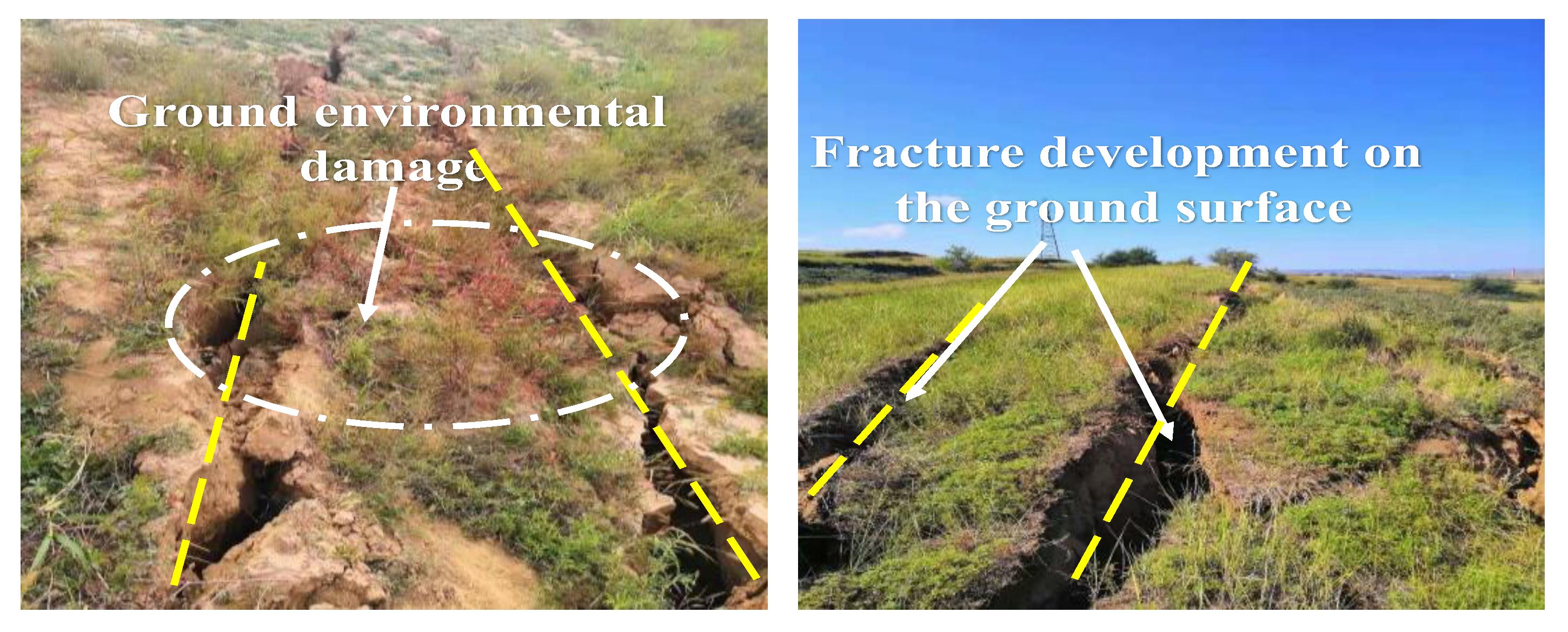


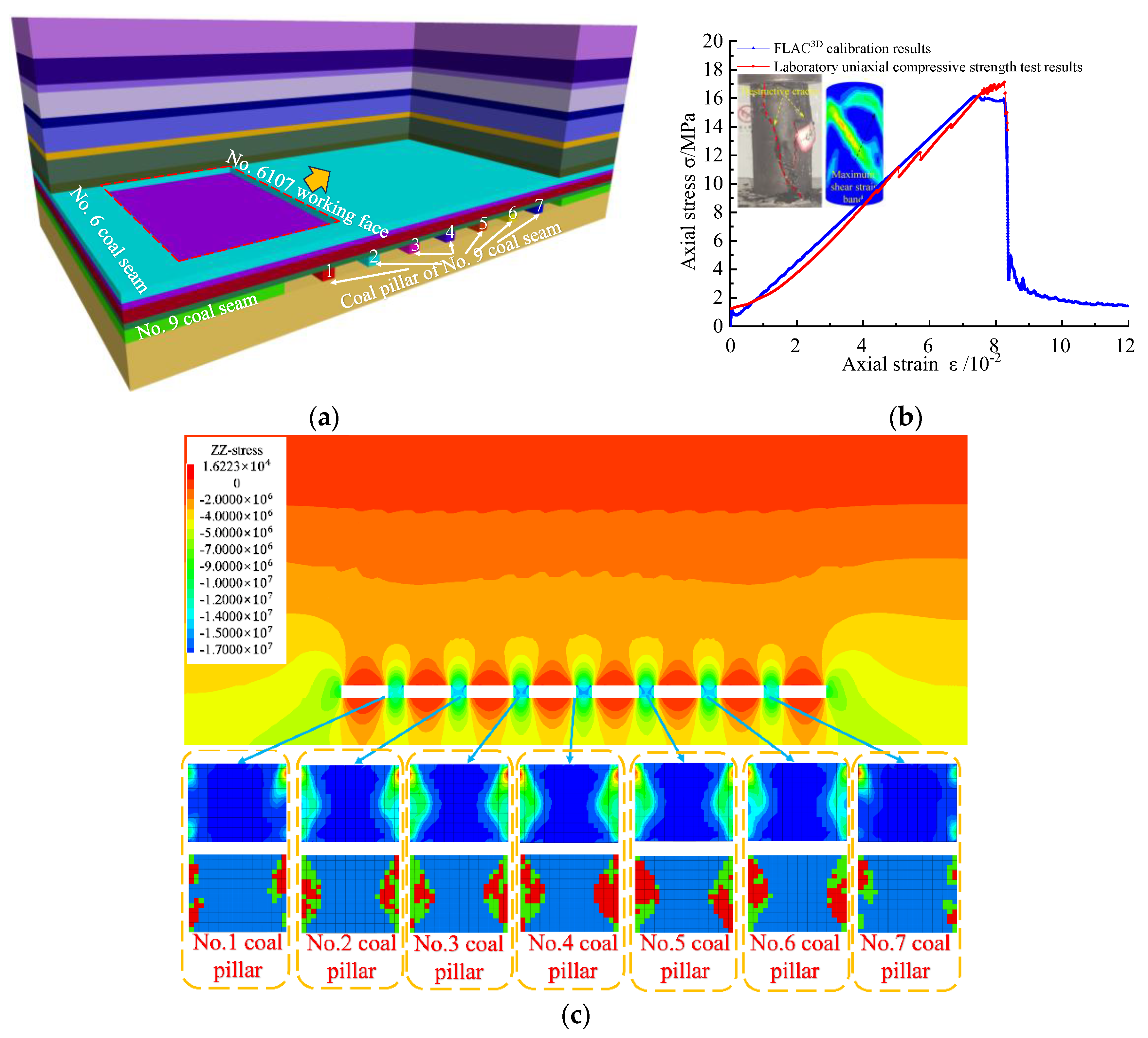
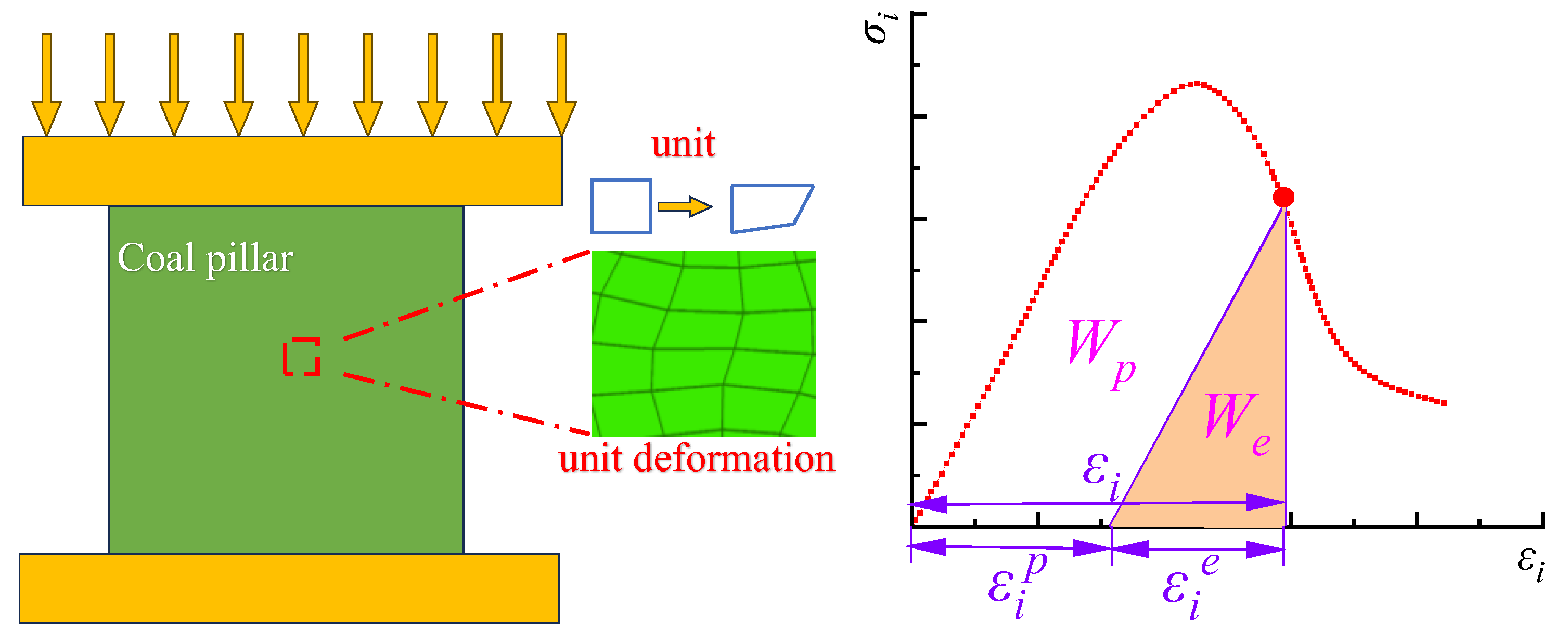

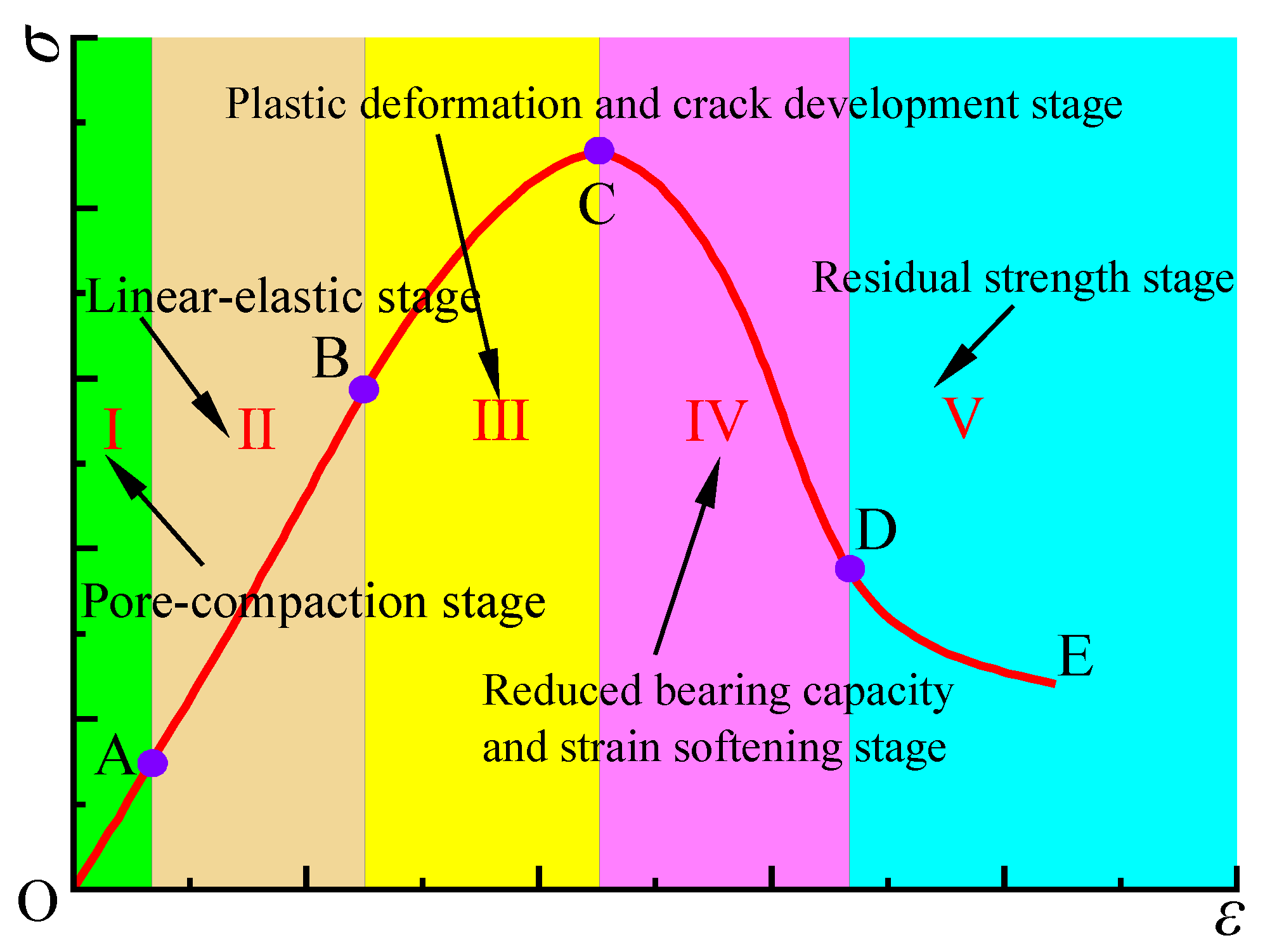
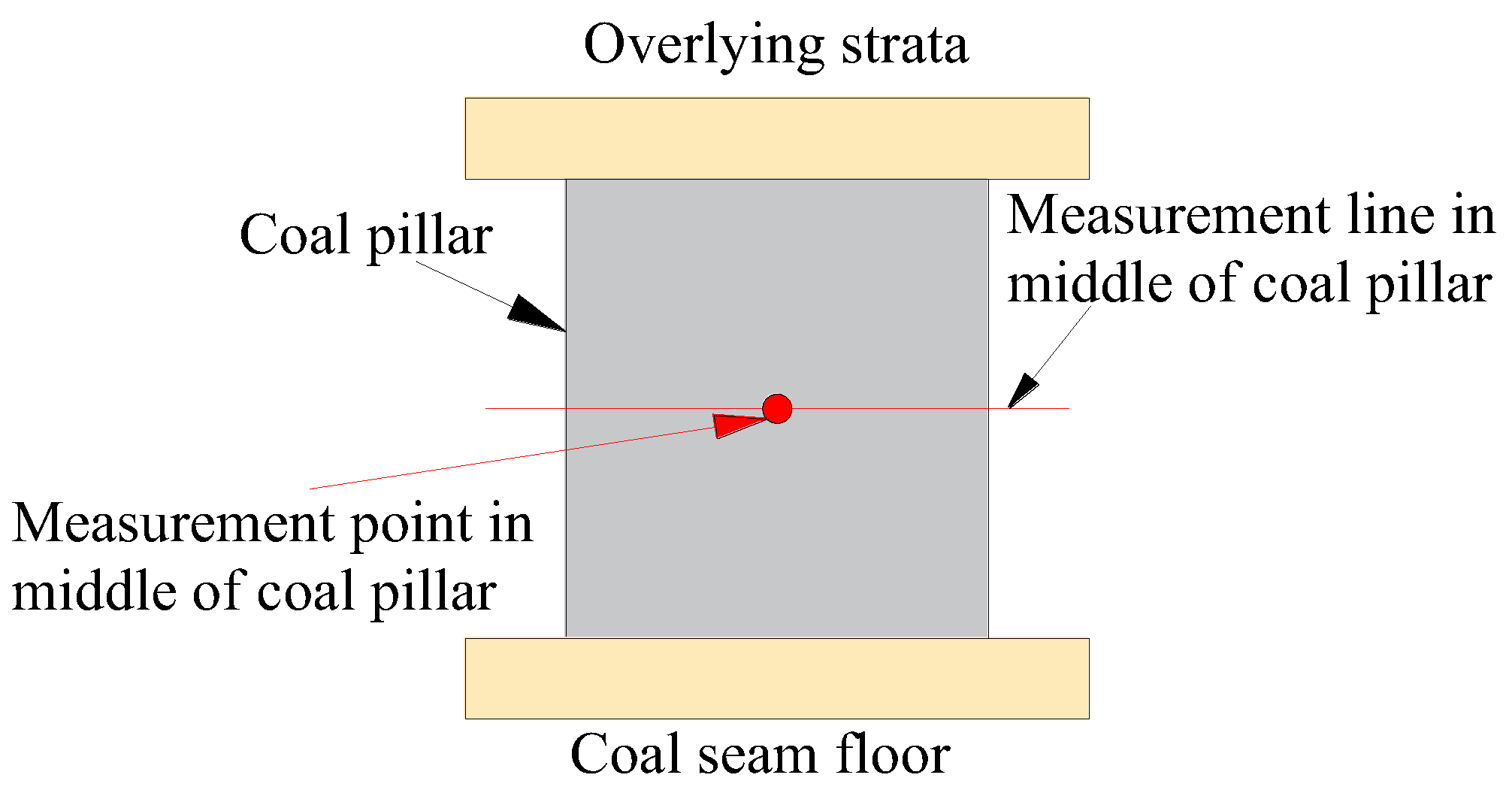
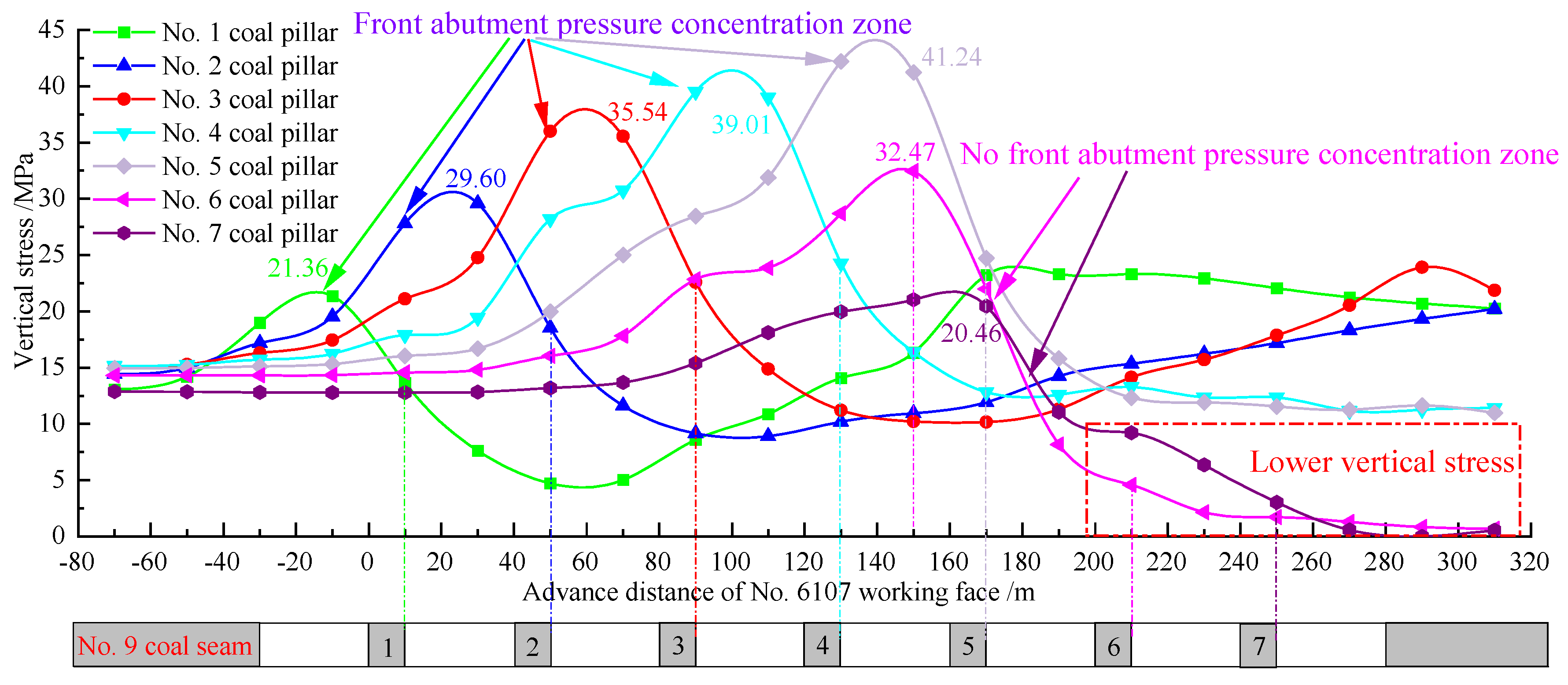
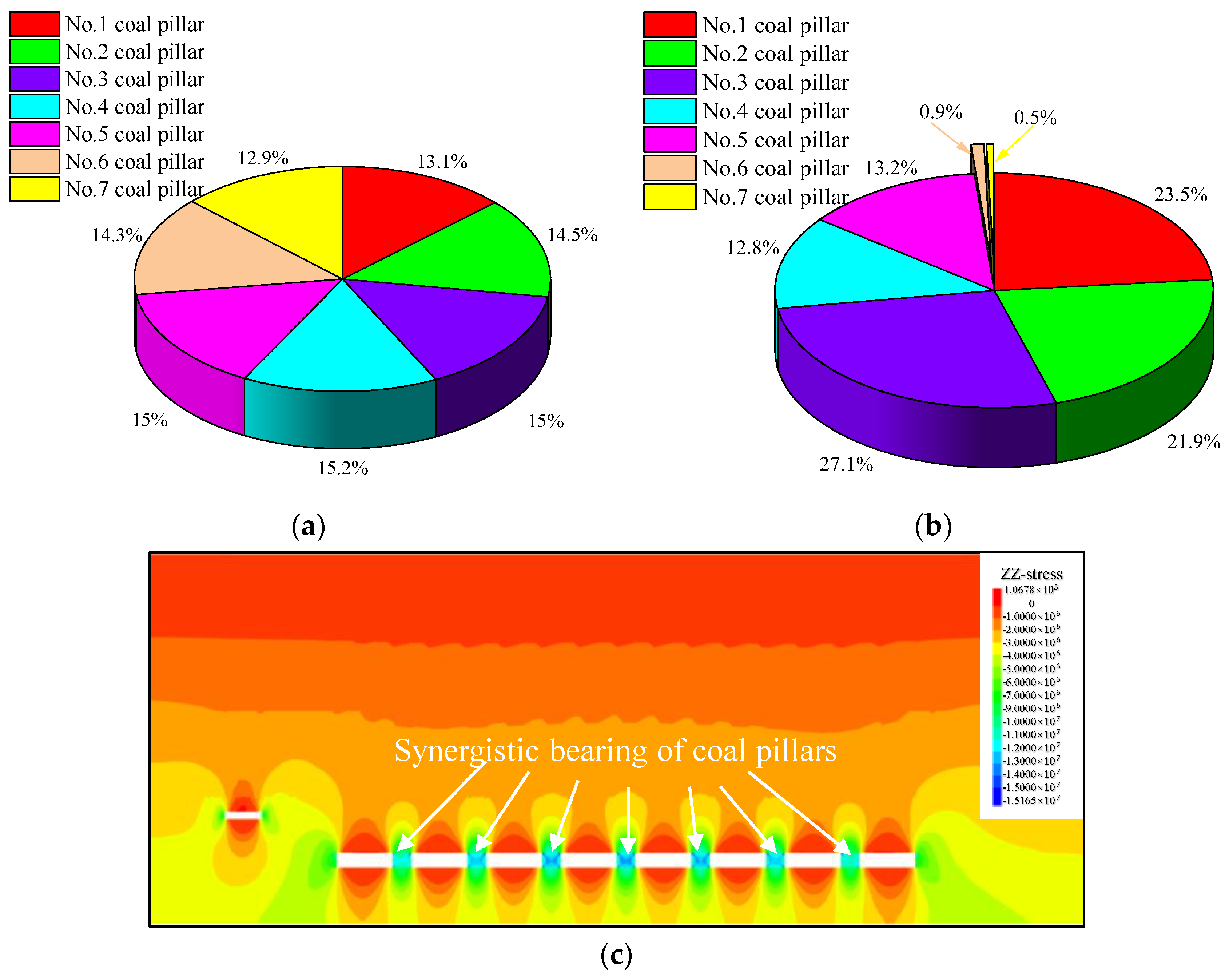
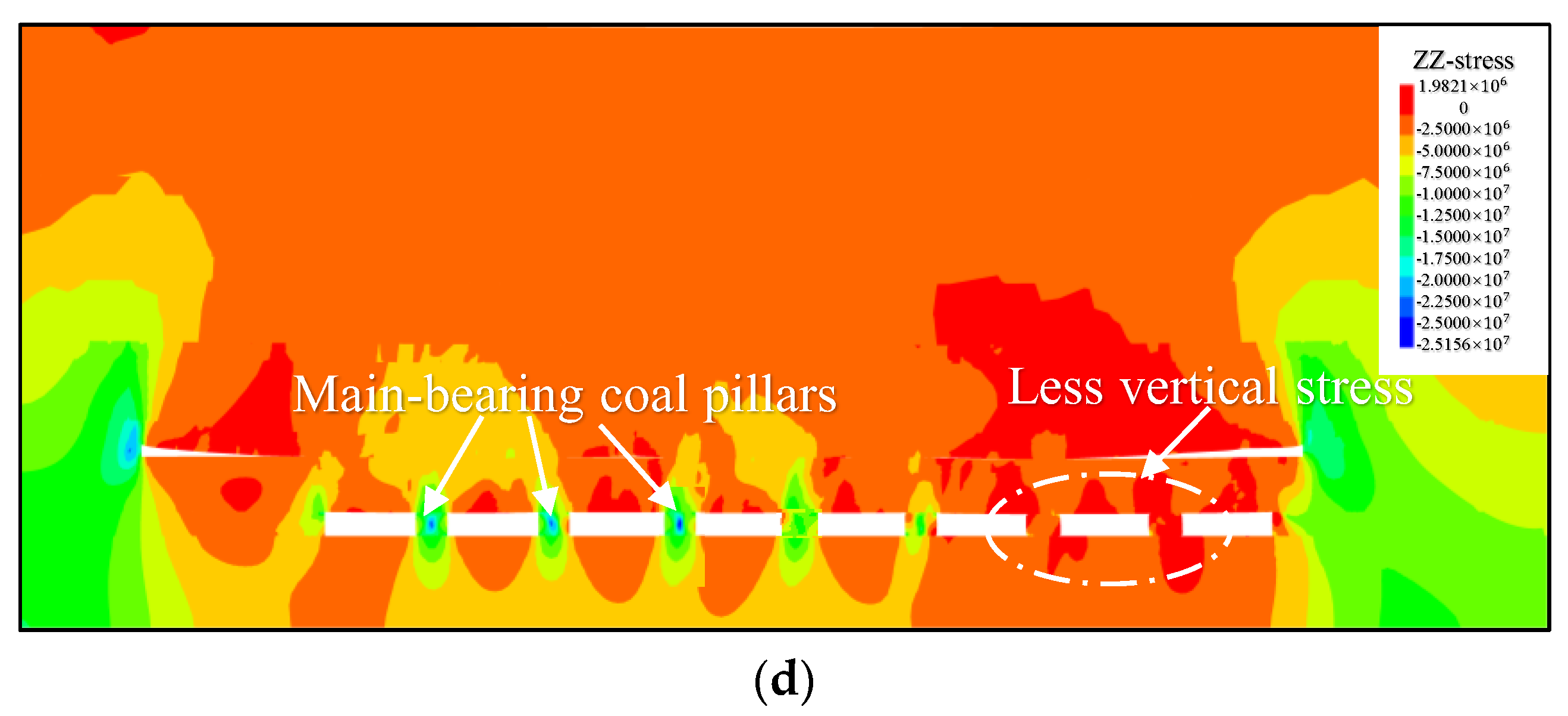


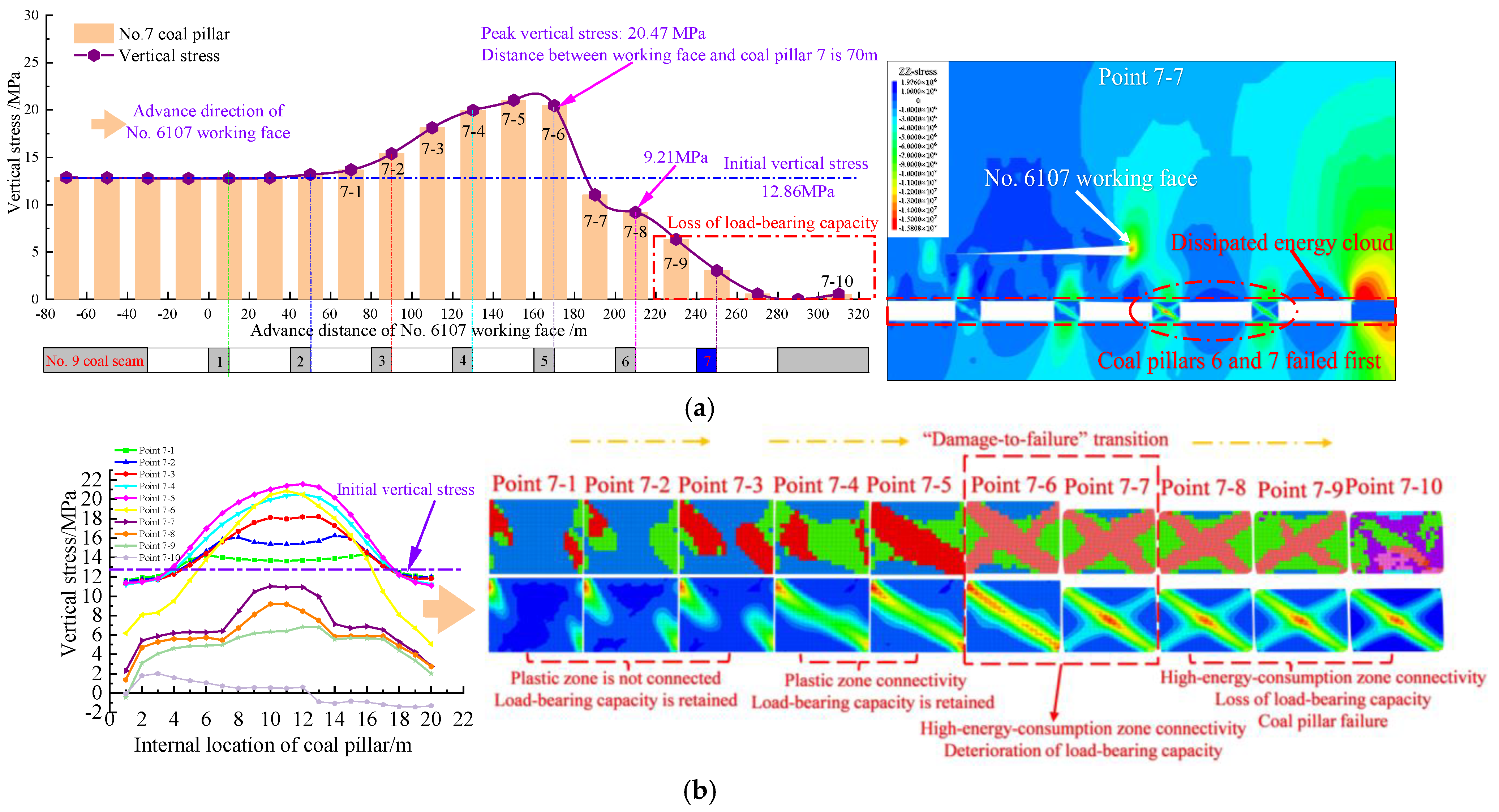


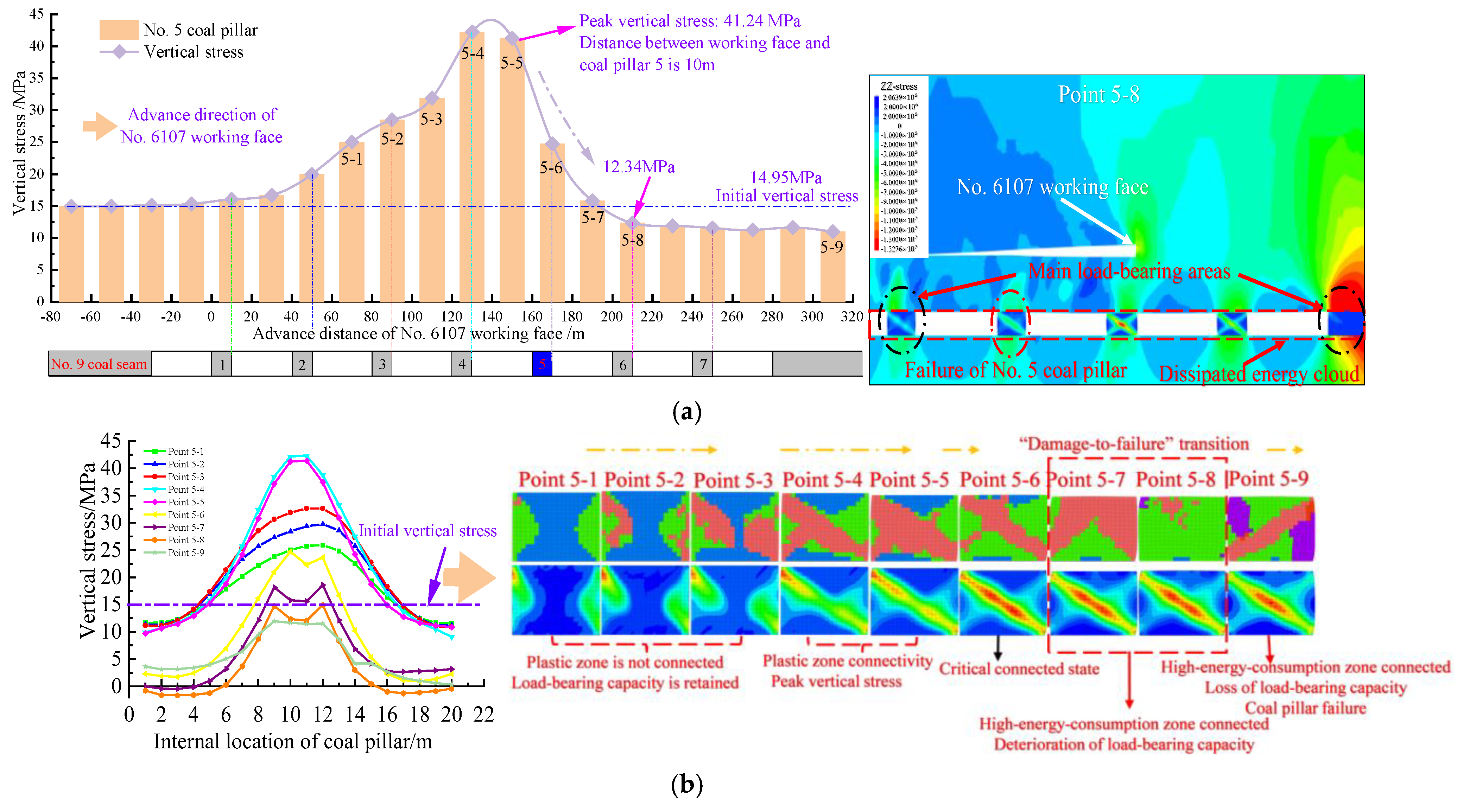


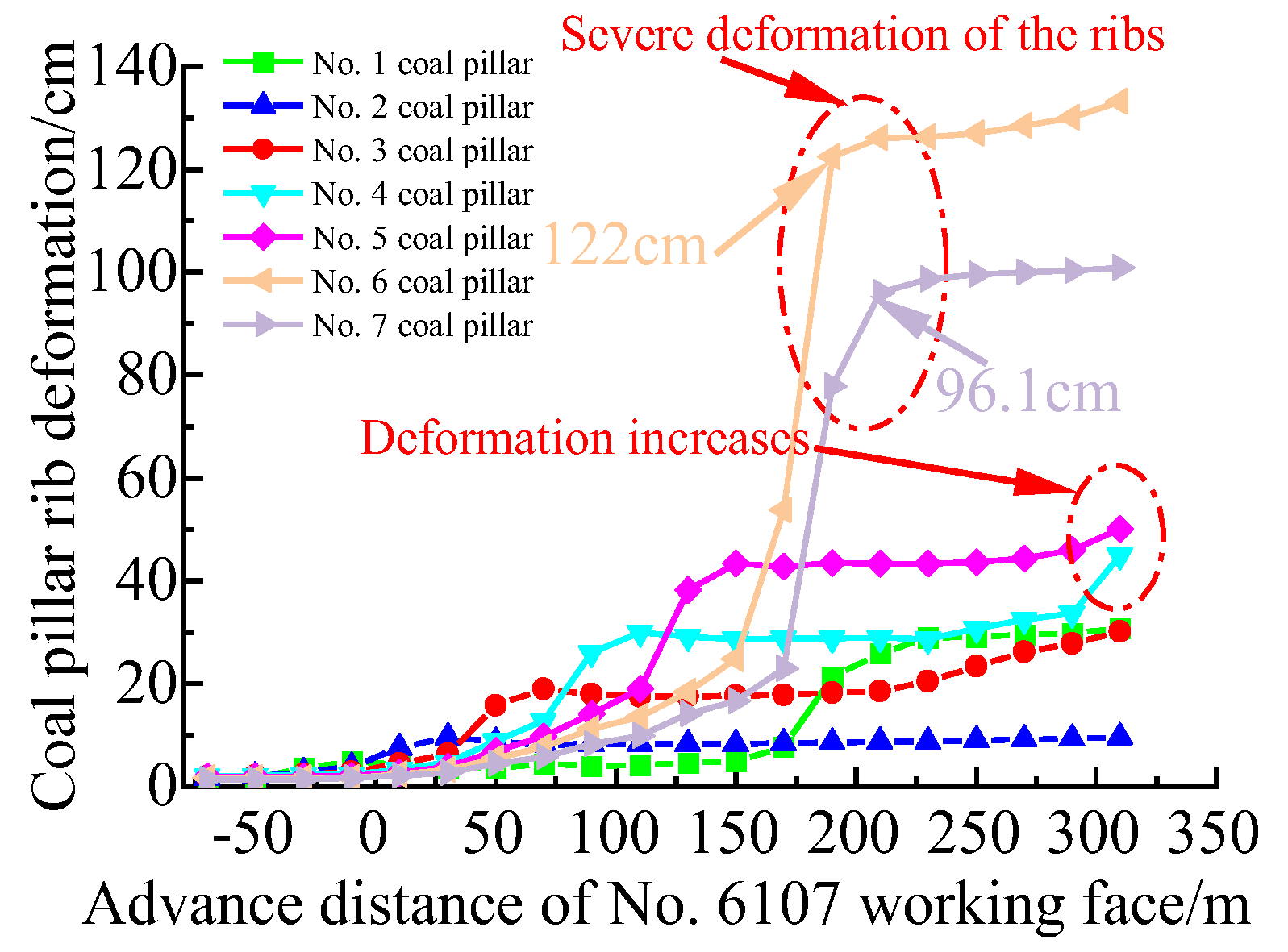
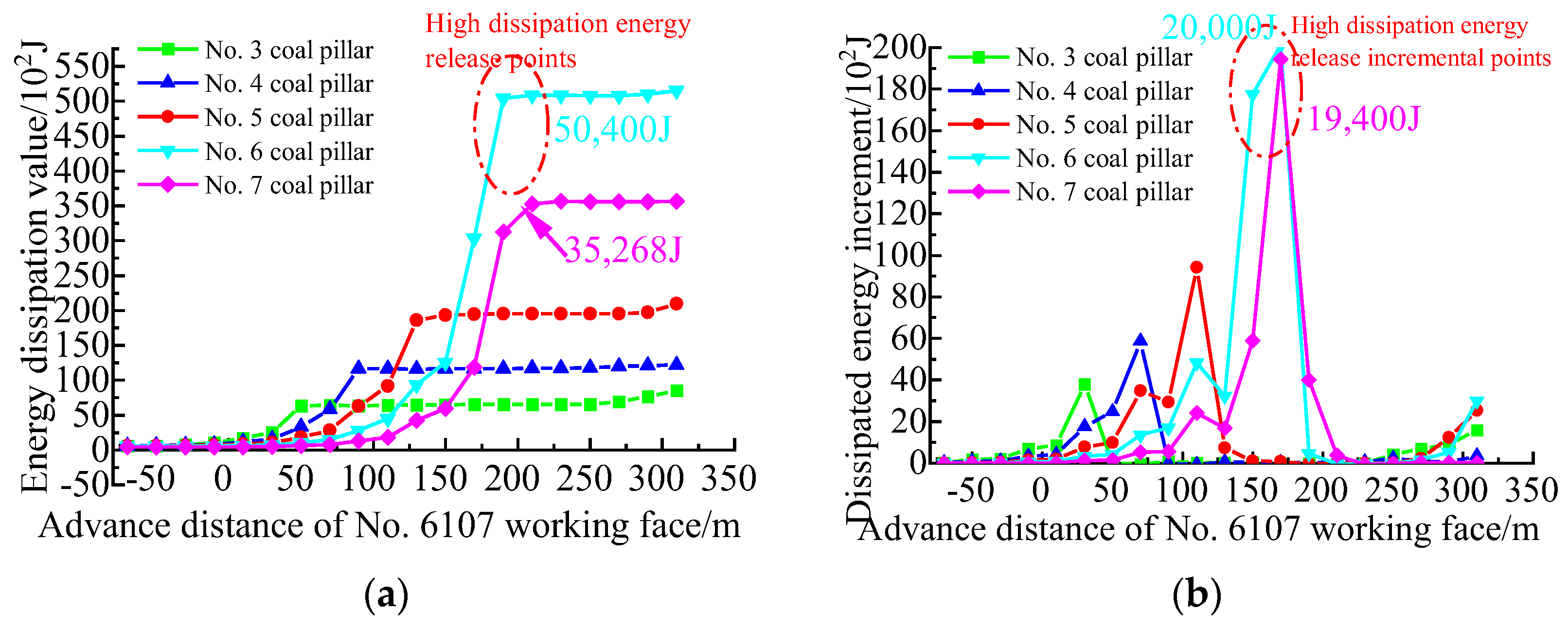





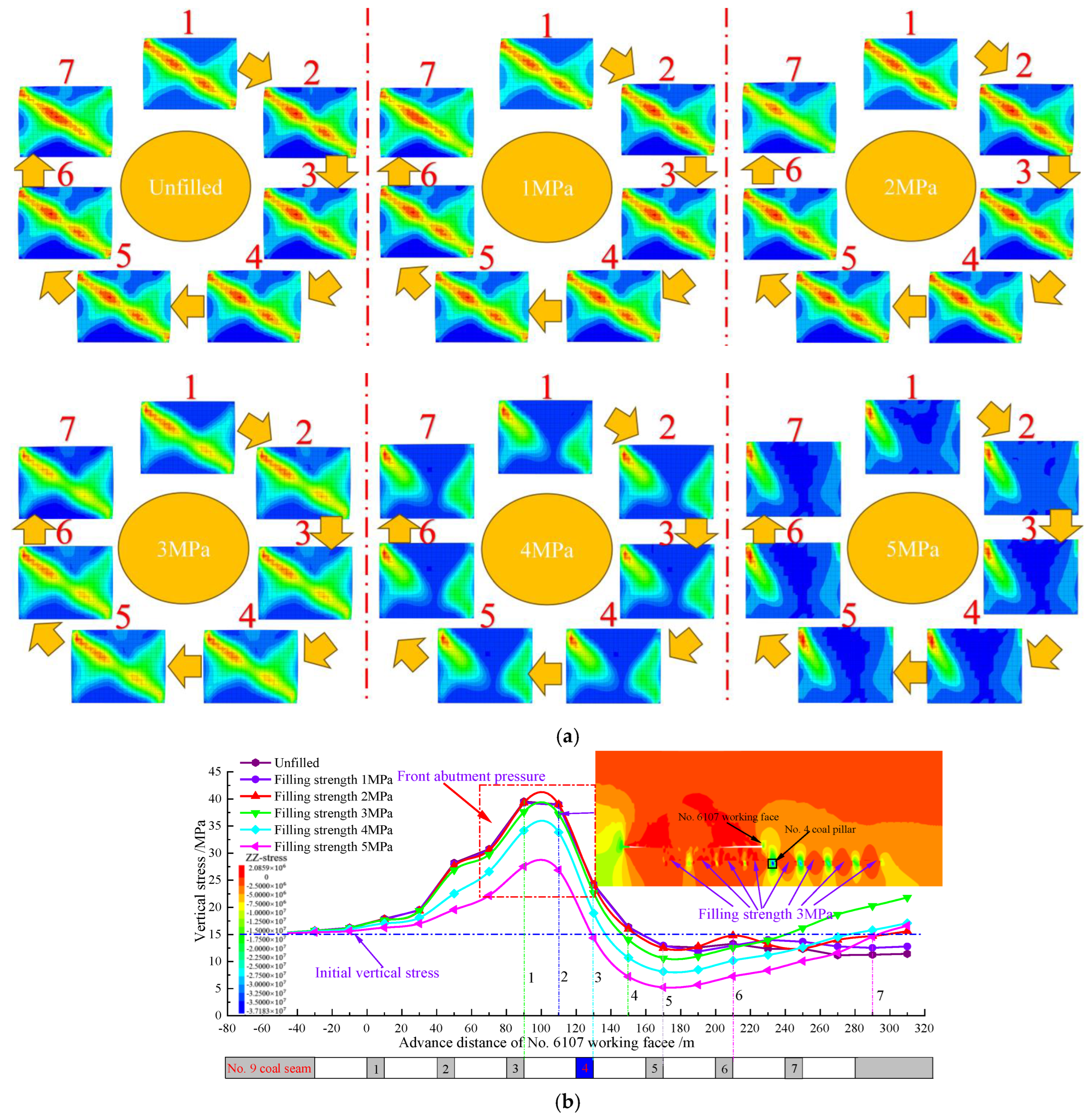
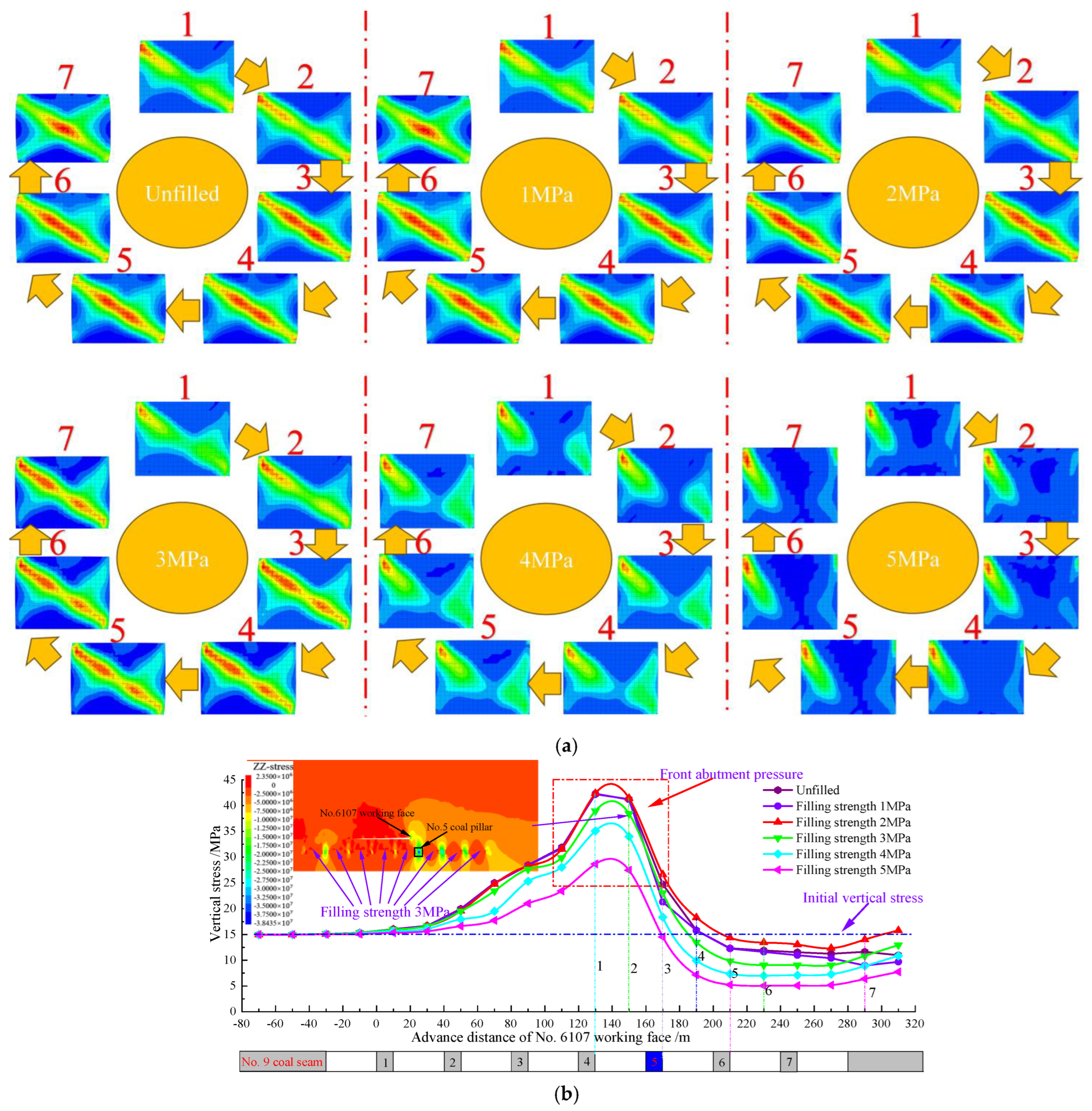




| Lithology | Bulk Modulus (GPa) | Shear Modulus (GPa) | Internal Friction Angle (°) | Cohesion (MPa) | Tensile Strength (MPa) | Density (kg/m3) |
|---|---|---|---|---|---|---|
| Mudstone | 3.51 | 2.67 | 43.00 | 1.64 | 1.24 | 2520 |
| Sandy mudstone | 5.58 | 3.74 | 36.00 | 1.25 | 2.10 | 2480 |
| Siltstone | 8.3 | 6.1 | 31.40 | 3.25 | 5.80 | 2420 |
| Fine sandstone | 5.4 | 3.6 | 45.30 | 2.64 | 3.10 | 2360 |
| Medium sandstone | 5.10 | 2.70 | 36.50 | 2.10 | 1.56 | 2150 |
| No. 6 coal seam | 2.51 | 1.70 | 24.50 | 1.10 | 0.87 | 1350 |
| Fine sandstone | 5.1 | 3.3 | 40.10 | 2.58 | 5.43 | 2350 |
| No. 9 coal seam | 2.2 | 1.65 | 27 | 1.5 | 0.81 | 1415 |
Disclaimer/Publisher’s Note: The statements, opinions and data contained in all publications are solely those of the individual author(s) and contributor(s) and not of MDPI and/or the editor(s). MDPI and/or the editor(s) disclaim responsibility for any injury to people or property resulting from any ideas, methods, instructions or products referred to in the content. |
© 2023 by the authors. Licensee MDPI, Basel, Switzerland. This article is an open access article distributed under the terms and conditions of the Creative Commons Attribution (CC BY) license (https://creativecommons.org/licenses/by/4.0/).
Share and Cite
Li, Z.; Fan, J.; Feng, G.; Qi, C.; Zhang, J. A New Method for Identifying Coal Pillar Instability Based on Energy and Stress Correlation Characteristics and Its Engineering Application. Minerals 2023, 13, 1507. https://doi.org/10.3390/min13121507
Li Z, Fan J, Feng G, Qi C, Zhang J. A New Method for Identifying Coal Pillar Instability Based on Energy and Stress Correlation Characteristics and Its Engineering Application. Minerals. 2023; 13(12):1507. https://doi.org/10.3390/min13121507
Chicago/Turabian StyleLi, Zhu, Jianyu Fan, Guorui Feng, Chengen Qi, and Jingyu Zhang. 2023. "A New Method for Identifying Coal Pillar Instability Based on Energy and Stress Correlation Characteristics and Its Engineering Application" Minerals 13, no. 12: 1507. https://doi.org/10.3390/min13121507






